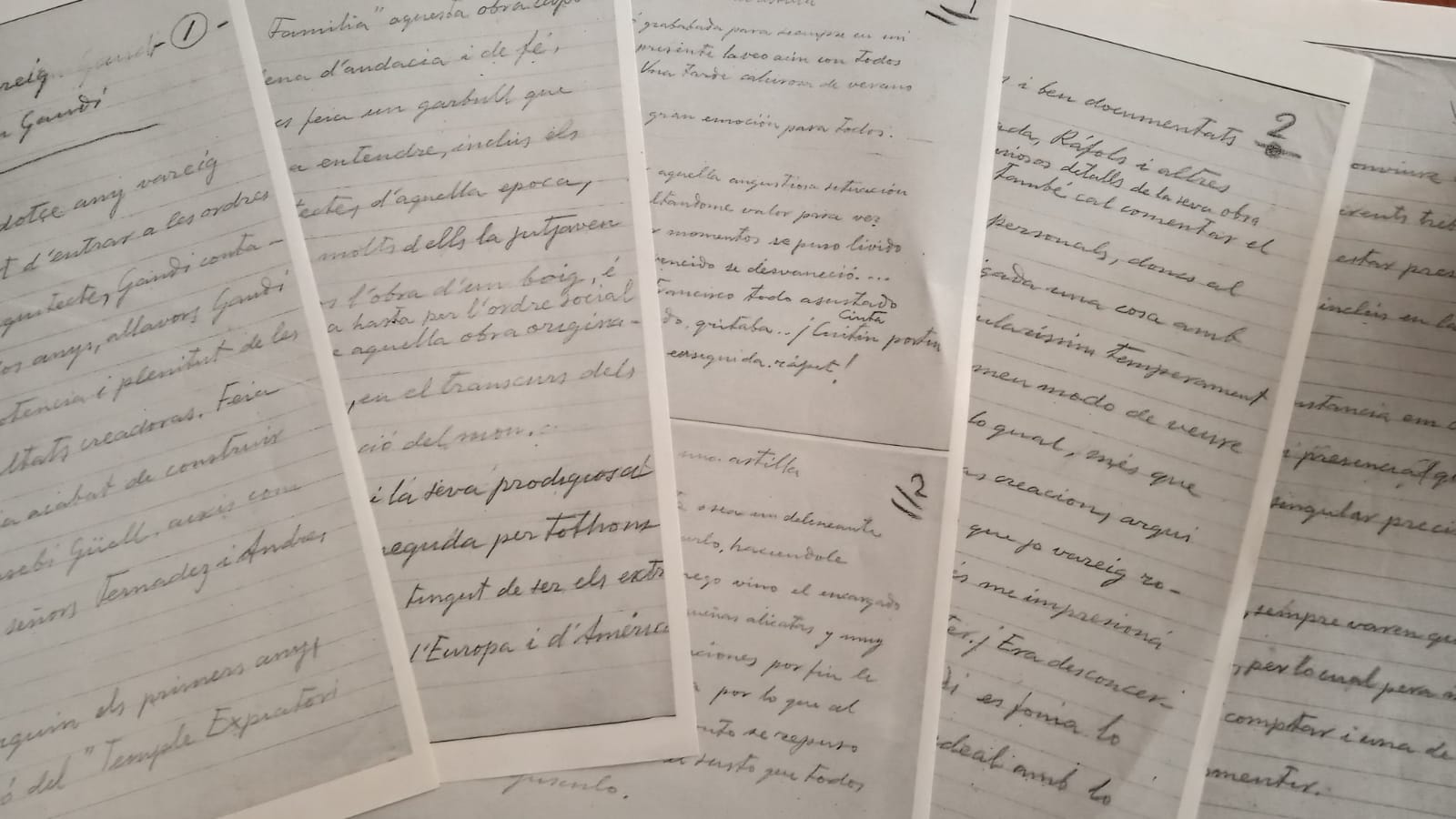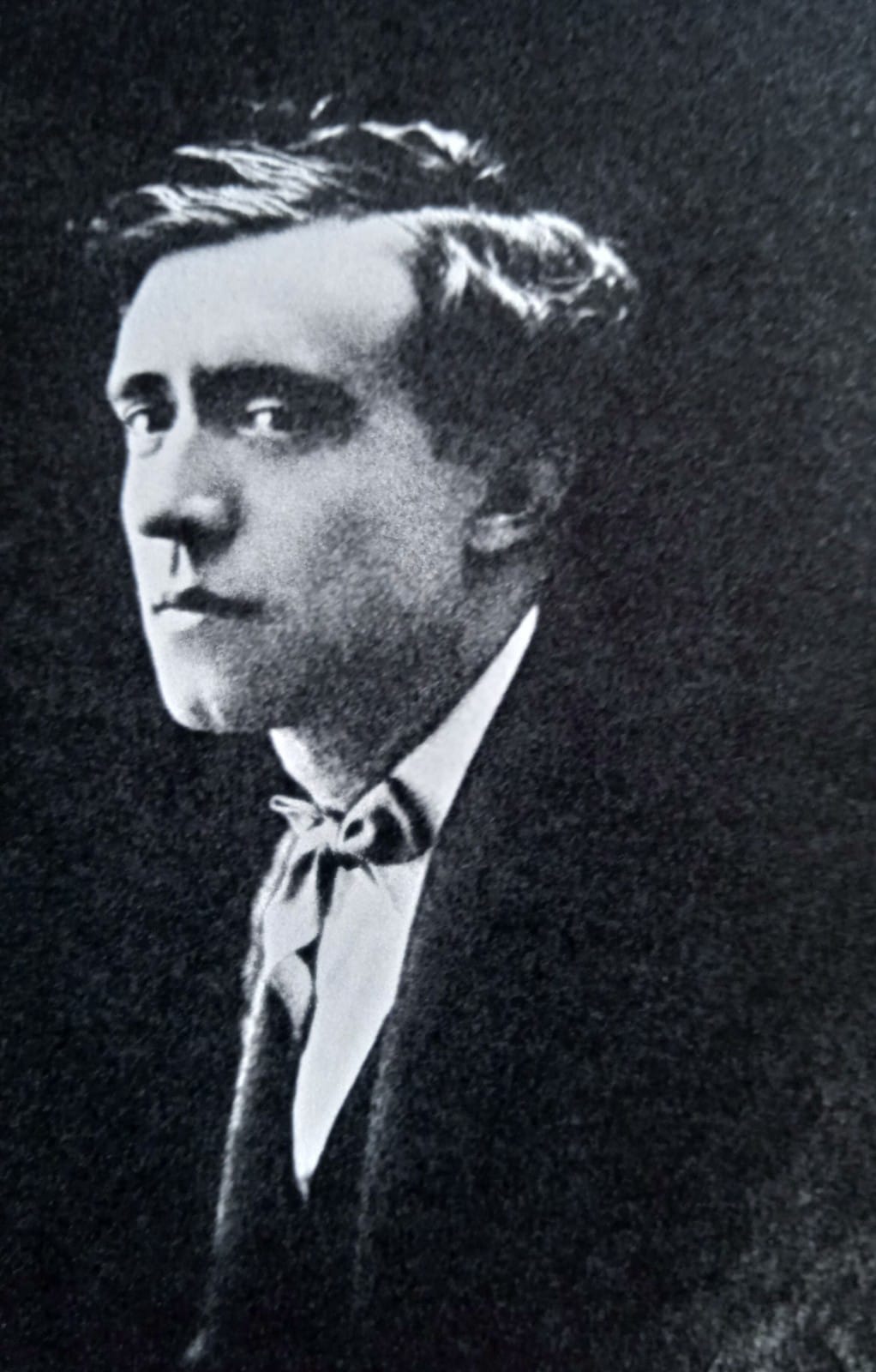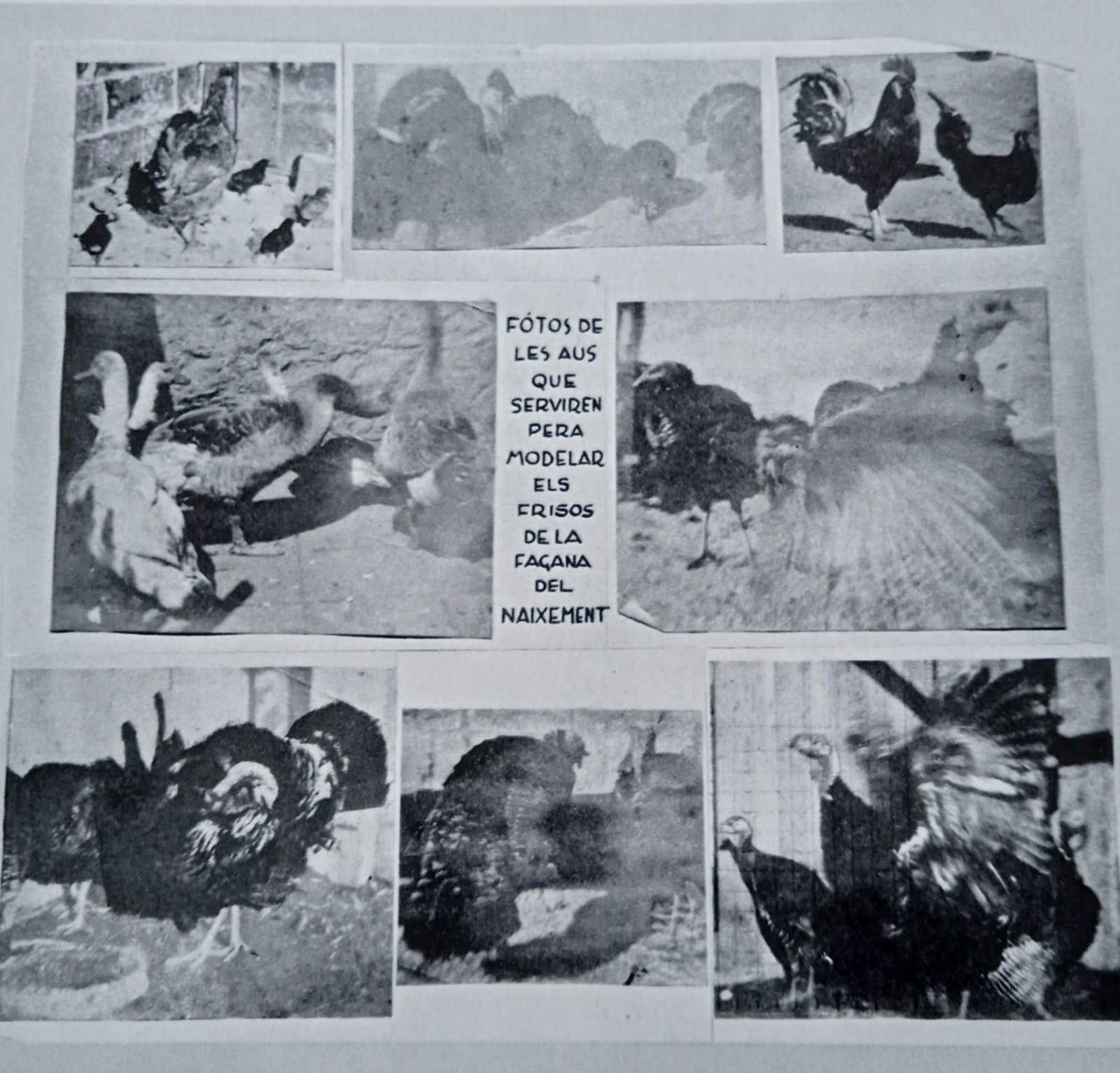Mariàngels Fondevila
Over the years, the popular cartoonist and humorist Richard Opisso i Sala (Tarragona 1880-Barcelona 1966) wrote his memoirs in a “Bohemian” style and with some inaccuracies but interesting as a testament to a time of effervescence. These manuscripts (preserved by the Archive of the Opisso Family) recall intimate and unofficial stories of artists from the turn of the century. One of the protagonists was Antoni Gaudí, “the brilliant architect with whom I was present in every accident of his life, even in the privacy of his home.” Opisso outlines his bittersweet memories, some of which have been published.

Ricard Opisso’s writings. Opisso family Archives.
Biographical profile
In 1892, the teenager Opisso entered as a draftsman and photographer in Gaudí’s workshop in the Sagrada Família in Barcelona. He was placed there by his father, the art critic Alfred Opisso. Gaudí, then, over forty years old, was at the peak of his creative faculties, but his character was special and disconcerting: “he fused the divine and the human”. First of all, Opisso clarified aspects of his controversial biography. For example, he was born in Reus and not Riudoms. Or that his father was a modest boilermaker as well as a builder of utensils for the distillation and manufacture of all kinds of alcohol, who died in 1906. To the irony of fate, Gaudí’s niece, Rosita Egea, with whom he lived in the Park Guell house, died of alcoholism.

Photograph of Ricard Opisso (Robert Descharnes, Clovis Prévost, La vision artístique et religieuse de Gaudí, Lausana, 1969).
Art-science and temperament
Opisso pointed out that the older that Gaudí got, the more abstract and revolutionary his creations were: Park Güell, the Casa Milà or the Colonia Güell, were true prodigies of technique and construction science, the result of a series of musings and mathematical equations that only his talent and tenacity could bring to the fore. He emphasised the importance of young collaborators, such as Josep Maria Jujol, who induced Gaudí to make his creations even more volcanic and surreal.
On a more anecdotal note, Opisso was shocked at how this simple, modest-looking man would humiliate important or high-ranking people: “He made them feel awful.”

Drawing by Ricard Opisso with Gaudi weakened by abstinence (Robert Descharnes, Clovis Prévost, La vision artístique et religieuse de Gaudí, Lausana, 1969).
Voluntary poverty and bold spirit
Gaudí was proud of his poverty, something which was absurd and incongruous – according to Opisso – because for a man like him, with healthy farmland in Reus and who had built stately homes and palaces, it was not lawful for him to be so poorly dressed. A good woman gave him five cents. An extravagance he shared with the painter Toulouse-Lautrec, son of the nobility, who walked in the streets of Montmartre like a miser but with other intentions. Gaudí renounced luxury and worldly vanities in order to do God’s will. He was a pure and honest man; he went on to say, like a stone before the pleasures of the table and the bed!
He remembers the shock when one day Gaudí stabbed himself with a splinter, that penetrating and terrifying blue-eyed look, his heroic fasting at Lent, the little caution in the face of danger (he walked like a tightrope walker on the scaffolding and with portable wooden steps from which he instructed the bricklayers). And how, despite suffering from bad feet, he walked daily from the Sagrada Família to Sant Felip Neri, where he asked God for help in his endless cathedral. When he was walking down the street, he was obsessed with the fact that it was the vehicles that had to stop, not the pedestrians!

Ricard Opisso, Gaudí with students from the School of Architecture. COAC Archive
Panic of photography
In these writings, Opisso recalls that one of Gaudí’s rarities was that he panicked at the sight of a Kodak camera and got mad when someone tried to photograph him. Utrillo tried in vain. The nice and smiling Rusiñol said to him: “Man of God, don’t be like that, don’t be afraid, we’ll do it with bromide”. Gaudí replied – you are always joking. I don’t want to and I don’t want to … the romance is over. “
Opisso did drawings of Gaudí while he was alive, as well as on his deathbed, and other personalities who accompanied him, such as Pere Mañach, who had collaborated in the locksmith work on the various houses of Gaudí, Puig Boada and Cèsar Martinell.

Workshop of the Sagrada Família where the models of the statues of the Portal del Naixement were stored. Figures of the humble people that Gaudí moulded. COAC Archive
Natural moulding: the realistic sculpture
Opisso recounts his “diabolical” projects to mould the figure of the natural in the name of truth. He had already used this realistic sculpture process with Llorenç Matamala, fascinated by the architect. At the Hospital de la Santa Creu they photographed the dying and moulded corpses. Opisso was in charge of twisting the necks of the beasts, which were then emptied of the natural. He also made lizard moulds and fed the particular bird and reptile zoo in the Sagrada Familia.

Ricard Opisso, Photographs of the birds used to mould the friezes of the Nativity façade of Sagrada Familia. COAC Archive
He recalls Gaudí’s recklessness when he wanted to empty Opisso himself, whom he ordered to be undressed and threw chalk at him, causing him to suffocate and he felt that his life was in danger. He denies that certain sculptures on the façade of the Nativity belonged to the sculptor Carles Mani, to whom they had been attributed.
Street musicians, models for the Adoration of the shepherds / José, guard of the works that served as a model for Judas / Goatherd, a model for Pontius Pilate for the facade of the Passion of the Sagrada Família. COAC Archive / Ricard Opisso. Girls from the orphanage of the Sant Josep Convent who served as models for plaster angels. Museu Nacional d’Art de Catalunya.
THE ALBUM OF OPISSO
Between 1892 and 1900, Ricard Opisso took photographs for the study of the sculptures of the Sagrada Familia, accompanied by a brief description, and they were compiled into an album. A selection of this material can be seen in the Gaudí exhibition at the Museu Nacional. Here we can discover the models of the sculptures of the humble Street Musicians; the watchman of the works under construction who acts as Judas, the sister of a mason who works as a Virgin, or the photographs of the different birds that were used to shape the friezes on the façade of the Nativity.

Ricard Opisso, workers of the Brigade of the Contractor Pardo in Park Güell, COAC
Furthermore, this material was also published in the brilliant monograph La Visió artística i religiosa de Gaudí (The Artistic and Religious Vision of Gaudí), with a preface by Salvador Dalí, which recalls the betrayals perpetrated by Gaudí’s contemporary panegyrists. One of them is that the Sagrada Família smells of holiness. A statement that anticipates the most extraordinary proposal that can happen to an artist: to be called to raise the altars as intended by the Associació Pro Beatificació of Antoni Gaudí.
FAREWELL GAUDI
Ricard Opisso, Group of beggars who served as a model for the painter Mir for La catedral dels pobres (The cathedral of the poor) COAC Archive Joaquim Mir, La catedral dels pobres, 1898, MNAC 212858-000
Through Joaquim Mir, who at that time was painting La catedral dels pobres (The cathedral of the poor) in situ and using the group of beggars photographed by Opisso as a model, he contacted Els Quatre Gats. After a hard day’s work at the Sagrada Familia, he frequented that tavern of bohemian artists who Gaudí didn’t trust. And in the early hours of the morning he attended other venues of dubious reputation such as the Eden Concert. Opisso was obsessed with Gaudí’s visible genius and austerity. In a letter, Picasso would write: “If you go to Opisso, tell him to send Gaudí and the Sagrada Familia to hell.”

Ricard Opisso. Isidre Nonell and Pablo Picasso,1898, Museu Nacional d’Art de Catalunya.
Around 1904 Opisso stopped working in “that prison.”And according to him, his vacancy was filled with other submissive and suffering helpers. Among them, the painters Jaume Llongueras, Iu Pascual and Joaquim Torres Garcia, who also evoked his relationship with Gaudí in Història de mi vida (History of my Life).
However, that’s another story.*
*Our thanks to the Opisso family for providing us with access to the writings of Ricard Opisso.
To find out more:
Robert Descharnes, Clovis Prévost, La vision artístique et religieuse de Gaudí, 1969
John Richardson, Picasso. l. Una biografía, 1881-1906, 1995
Juan José Lahuerta, Gaudí, 2002
Art Modern i Contemporani














